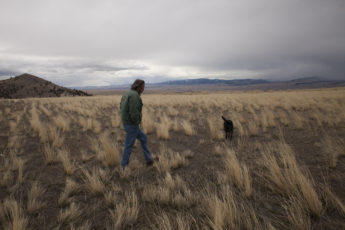Montana State Parks AmeriCorps is part of the solution — not THE solution — to state parks staffing shortages.
Paradise Room at Lewis and Clark Caverns
The network of caves at Lewis and Clark Caverns State Park is a far cry from Montana’s bright blue skies and dry mountain air. The underground rooms are dark, damp, and cool. The walls, floors, and ceilings are covered with mineral-rich rocks that have slowly formed over thousands of years into ghoulish shapes and striking pillars.
The Classic Cavern Tour — offered dozens of times a day during the summer months — is a two-mile adventure through these formations. To complete the tour, participants must duck, bend, slide, and tackle more than 600 stairs. It’s a powerful experience, but all of that crouching and climbing requires some physical skill. It’s not for everyone. If this were the only way to tour the caverns, a large segment of the population wouldn’t be able to access this amazing, history-rich place.
Fortunately, there is another option. The Paradise Tour is a shorter, less-strenuous — but equally-impressive — alternative that is ideal for people with physical limitations or families with small children. Offered multiple times a day during the height of the summer tourist season, the Paradise Tour is made possible by Montana State Parks AmeriCorps members, who often serve as guides.
Meeting Visitor and Park Demands
Photo co. Parks in Focus
Our state parks are extremely popular among Montanans and out-of-state visitors alike, but they are also some of the most underfunded parks in the entire region, falling well below Wyoming and the Dakotas. Tight funding leaves the staff at Lewis and Clark Caverns, and at many other parks throughout the state, stretched thin and searching for creative ways to handle the increasing visitor log and endless list of maintenance projects.
“We have more people coming than we can actually serve,” said Rhea Armstrong, the park manager for Lewis and Clark Caverns. “It’s because of the AmeriCorps people that we can have the bodies to do that. That’s the reason we can do our Paradise Tours.”
AmeriCorps members across the state provide services to the parks that park staff do not have the time or capacity to complete. Montana is one of six states where AmeriCorps members are assigned and directly integrated into the state’s park system. This year, there are 18 AmeriCorps members serving across Montana’s 55 state parks. In some situations, one AmeriCorps member covers multiple parks; in other cases, like with Lewis and Clark Caverns, two or three AmeriCorps members serve at a single location. This year, more than 30 parks throughout the state — and the thousands of people who visited them — benefited from this service program.
The tasks these AmeriCorps members take on vary from park to park. AmeriCorps staff work closely with the individual park managers to design projects that meet the specific needs of an area and are well-suited to the skills of the person serving.
“We really try to see who has the staff, who has the resources, and who has the need,” said Joe Naiman-Sessions, the Americorps Program Coordinator at Montana State Parks. “What projects do they have and how impactful are those projects on the communities, on the parks, and on the person who is doing those projects?”
AmeriCorps Member Steph Holton on her way to Wild Horse Island.
Americorps member Steph Holton serves at Wild Horse Island State Park. Located on an island in Flathead Lake, this unique park is a popular place for boaters and families to picnic, hike, and view wildlife. However, years of overuse and off-trail travel have carved a network of non-designated social trails that can negatively impact the plants, wildlife, and scenic views.
Steph’s role at Wild Horse Island is to identify as many of these social trails as possible and determine how many folks are using them. The information she gathers helps park staff figure out how to close non-designated trails while still ensuring users have plenty of access to enjoy this special place.
“[AmeriCorps members and other volunteers] are imperative to our operation,” said Amy Grout, the park manager for Wild Horse Island. “It’s not like we could get creative with our schedules. It would be impossible for us to operate our season without [AmeriCorps].”
In addition to projects at individual parks, which vary from removing weeds to hosting campfire programs, AmeriCorps service members also work together to improve the overall state parks system and educate folks about what our parks have to offer. For example, a large contingency of AmeriCorps members turned out for the Butte Folk Fest this year, where they set up a table and answered visitors’ questions about the our incredible parks.
AmeriCorps member Steph Holton surveying the trails on Wild Horse Island.
Benefits Go Both Ways
Americorps member Mirandi Bakken at the Missouri Headwaters State Park
Hailing from North Dakota, Mirandi Bakken is studying anthropology at Montana State University. She spent this past summer serving with AmeriCorps at the Missouri Headwaters State Park, a historical park with unique geographic features. Mirandi worked with local school groups, primarily teaching kids anywhere from 6 to 16 years old about history, nature, and science. Without her, Missouri Headwaters wouldn’t have been able to make as many programs like this available to nearby schools.
“I think it really offers them the opportunity to be learning out in the environment,” said Mirandi, referring to kids who completed the program.
Mirandi also attended the weekly farmers’ market in Three Forks throughout the summer, where she talked to community members and tourists about all the benefits Montana’s state parks have to offer.
“A career in the state parks wasn’t even on my radar,” she said. “There’s more to it than fish and wildlife.”
Service Members Fill A Gap, Not the Entire Hole
AmeriCorps members help caulk the gaps, but they don’t completely fill the holes.
“[Montana’s AmeriCorps program] is a very cost effective solution,” said Naiman-Sessions. But this successful partnership is only part of the answer. “There’s still a huge staffing shortage.”
Even running the program requires some staff capacity. Park staff are charged with training and overseeing a new crop of AmeriCorps members each season. The parks also need to comply with a variety of federal regulations and red tape. Additionally, AmeriCorps itself is regularly on the chopping block at the federal level.
It’s also important to note that federal law prohibits AmeriCorps members from doing the same job as staff members or volunteers. They need their own unique project with their own specific duties. As a result, even though AmeriCorps members often offer services that the park would not otherwise be able to offer, they don’t replace park staff or the critical work they do, like maintenance tasks, bookkeeping, and interpretation.
“They’re doing the things that we as a park system don’t have the capacity to do,” said Naiman-Sessions, the AmeriCorps program coordinator. “They help ensure the long-term sustainability of the park.”
AmeriCorps service members leave a legacy across our state parks, and they finish the program with the skills and confidence to continue serving their communities and their country. Some AmeriCorps members are just days out of college when they’re handed the keys to a state park, where they are expected to develop and run a program that brings a lasting impact. They don’t do these things for money and recognition, but rather because it’s the right thing to do — which is about as Montanan as it gets.
-Amanda Garant
Got something to say to Prairie Populist? Send news tips, story ideas and comments to [email protected]. If you have something to submit, or an idea for a story you’d like to write for us, check out our Submission Guidelines here.


